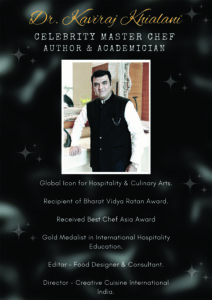
CELEBRITY MASTER CHEF DR KAVIRAJ KHIALANI
Sri Lanka, being an island with a tropical climate, coconuts and fish are two of the most influential components of Sri Lankan cuisine. Fish is made into curries, and coconut in some form or another, is a dominant ingredient in cooking. Rice and curry is the Sri Lankan staple, though various kinds of bread, both roti style flatbreads and even loaves of bread, are very common. A few things about Sri Lankan food can be said with certainty.
Sri Lankans thoroughly love spices, they love food that explodes with flavor, and many enjoy deep fried, and very tasty, snacks. Whatever you choose to eat in Sri Lanka, your mouth is going to rejoice with happiness. Though Sri Lankan food has parallels to South Indian food, yet it remains distinctly its own form of cuisine. The central feature of Sri Lankan cuisine is boiled or steamed rice, served with a curry of fish or meat, along with other curries made with vegetables, lentils, or fruits. Dishes are accompanied by pickled fruits or vegetables, chutneys, and sambals.
- Though Sri Lankan food has parallels to South Indian food, yet it remains distinctly its own form of cuisine.
- As a country that was a hub in the historic oceanic silk road, contact with foreign traders brought new food items and cultural influences in addition to the local traditions of the country’s ethnic groups, all of which have helped shape Sri Lankan cuisine
Throughout years of colonization and influence from other countries, Sri Lanka has adapted its food culture into a blend of different curry concoctions and tasty dishes. Sri Lankan cuisine is known for its particular combinations of herbs, spices, fish, vegetables, rice fruits. The cuisine is highly centred around many varieties of rice as well as coconut which is an ubiquitous plant throughout the country. Seafood also plays a significant role in the cuisine, be it fresh fish or preserved fish. As a country that was a hub in the historic oceanic silk road, contact with foreign traders brought new food items and cultural influences in addition to the local traditions of the country’s ethnic groups, all of which have helped shape Sri Lankan cuisine.
Some Basic Ingredients used in Sri Lankan Cooking
Ghee: A clarified butter made by simmering butter to remove the milk solids. It has a distinctive flavour, heats to temperatures well above butter without burning and keeps for extended periods of time unrefrigerated used in a number of recipes.
Coconut: The coconut palm is referred to in Sinhalese as a gift of the gods. Every part of the tree is used – in building, for utensils, right down to the milk, the oil and of course the flesh. Finely grated in sambals added to curries and baked into sweet delights, it is the quintessential Sri Lankan ingredient.
Curry leaves: Picked from a tree related to the citrus family, curry leaves are often fried in oil before using in curries and chutneys. Although also available in dried or powdered form, they are at their aromatic best when fresh and the freshness from its flavor once added to any dish is just amazing.
Drumsticks: A long, ridged dark green pod with a slightly bitter flavour that are a popular ingredient in vegetable curries, particularly kiri hodi or white curry. Discard the outer skin before scooping out the pulp in the soft centre.it is also a popular immunity boosting ingredient as we are aware and is used in a number of ways.
Samba Rice: A rice native to Sri Lanka, the samba rice grain is approximately 1/3 the size of basmati and has a distinctive flavour and aroma deemed by locals to be an acquired taste. Nutritionally, it’s hard texture results in a denser and more filling meal than most other varieties. The addition of a pandan leaf when cooking is said to dissipate the strong smell.
Chutneys, pickles and sambals: It would be incomplete to enjoy and relish a meal in Sri Lanka without any accompaniments. These serve to enhance the flavours of curries and awaken the taste buds. They range from savoury eggplant and tomato pickles, tangy lime and date chutneys to fiery sambals based on salt, lime, Maldive fish, chilli and onion.
Goraka: A souring and thickening agent unique to Sri Lanka, Goraka is a fluted orange fruit whose segments are dried, turning black. It can be soaked in hot water and ground to a paste or added whole and removed after cooking. It is most commonly used in fish curries such as ambul thiyal.
Curry powder: Ceylon curry powder gets its colour, aroma and distinctive flavour from dark roasting of its spice components, including coriander, cumin, fennel seeds, fenugreek and cardamom. Sri Lankan curries are generally classified as white: mild and rich in coconut milk, red, rich in chilli powder or ground chillies; or black, in which powered spice mixtures are given a deeper, richer flavour by pan toasting them until they are blackened.
Fenugreek: No Sri Lankan curry is complete without these small, brown square-shaped seeds, which add a slight bitterness and have a thickening effect on sauces. They must be heated slowly to prevent bitterness. Despite its strong flavour it is still very actively used with lentils, rice, pulses, veg and non-veg dishes as well in this cuisine.
Pandan Leaves: Most Sri Lankan households grow the pandan plant whose long green leaves are used to perfume curries and rice. Pandan is often referred to as the ‘Vanilla of Asia’, such is its beautiful aroma and also the presentation and eye appeal upon using it in our food and service patterns is just truly impressive & satisfying.
Maldive fish: Spiced, dried, smoked and finely shaved bonito, Maldive fish is the shrimp paste or fish sauce equivalent for Sri Lankan cuisine. It is a key ingredient in the essential pol, coconut sambals and is also sparingly used as a thickening agent in curries. Store Maldive fish in a screw top glass jar as it’s quite pungent!
SOME OF THE POPULAR SRI LANKAN DISHES
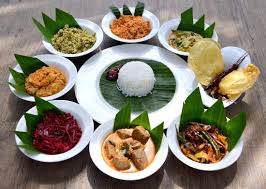
Sri Lankan cooking techniques and recipes are passed from generation to generation through word of mouth. Family recipes are never written in cookbooks, as the taste is unique to the family and their practices. They use traditional measurements for ingredients and cook to taste.
Cooking patterns and techniques are unique to the region they originate from. So that means even the same curry has a regional taste – locals can identify if it is from the north, south, west, east or hill country. Also, there is a huge variety of rice throughout the different parts of Sri Lanka. Different regions use different types, and the taste and aroma is often different.
Kitchen is the heart of the house and much similarly the Sri Lankans consider the kitchen to be a place of sacred and prosperity, giving energy to the family, they often worship the kitchen and pray for blessings to have a fruitful life. Preparing the hearth for the new year is also an age-old custom. Usually, clay mixed with cow dung is applied over the hearth for a fresh start for the next year. There are certain customs and practices related to the kitchen in Sri Lanka has lavishly aromatic and spicy cuisine. If you visit Sri Lanka, you should try these popular Sri Lankan dishes.
This cuisine is characterized mainly by its history and culture. Some dishes are so unique that you would not find them anywhere else in the world. Main dishes such as Rice and Curry, Those, Pol Sambal (Coconut Sambal), Mallum – Got Kola Sambal, Dhal or Lentil Curry (Parippu Hodi) and Fish Ambul Thiyal (Sour Fish Curry). Breakfast dishes like Hoppers (Appa) and String Hoppers (Indi Appa). Special occasions and festive dishes such as rice pudding (Kiribath) and sweets (Kavum, Kokis, Asmi etc.)
Hoppers (Appa) and String Hoppers (Indi Appa): Hoppers and string hoppers are popular breakfast or evening meals in Sri Lanka. Funnels are similar to leaven pancakes. The dough is fermented in the traditional way with a light palmoddy that gives the funnels a delicious liqueur flavor. Usually served with sambal. There are different types of funnels – egg funnels and a few sweeter varieties. String hoppers are made from rice noodles that are crinkled into flat spirals. It is served for breakfast and dinner with a thin fish or chicken curry, which contains only one or two pieces of meat, a dhal dish and a spicy sambal or fresh chutney.
Tempering is a cooking technique that is not found in the Western or Eastern cookbooks, but it is typically used to make Sri Lankan curries. The origin of the term is from the Portuguese during the colonial period. In Portuguese, ‘temperadu’ means ‘to fry and season.’ This is a shallow frying of onions, curry leaves and other condiments to release the flavor or accentuate it. Generally, the oil is heated to a very high temperature to bring about instant browning and release the aroma. This aroma helps in the secretion of digestive juices and whets the appetite.
Mallum or leafy salad is a must-have side dish along with other curries. There are over hundreds of varieties of leaves available in Sri Lanka. Mallum are usually made with a variety of finely chopped leaves, scraped coconut, tomato, lime, and spices. Sri Lankan parents usually encourage their children to eat fresh Mallum and salad, as fresh leaves have vitamins and minerals
Sri Lankan cooking artistry has mastered the technique of cooking food in clay pots, and clay pottery has been one of the oldest crafts in the country. A technically made and well-seasoned clay pot makes food tender and flavourful. The porous walls absorb water, which prevents food from going dry – therefore useful for long slow cooking. In addition, since less oil is needed to retain moisture, food cooked in clay pots are naturally low in fat. Researches have proved, food cooked in clay pots can be preserved for longer as it has antibacterial acidic moisture.
In order to get the best taste and aroma, traditional tools should be used, as there are no better alternatives. Even modern houses have traditional tools, such as grinding mill, pestle and mortar, etc. Although there are hundreds of products available at the market, they do not give the same taste and effect that traditional cooking tools give.
ONE OF THE BASIC RECIPE FOR A SRILANKAN CURRY/SPICE POWDER
Coriander seeds- 4 tsp
Cumin seeds- 3 tsp
Black peppercorns-1 tsp
Cinnamon stick-1-inch piece
Green cardamom-2-3 no
Curry leaves- 10-12 no
Dried red chilies- 2-3 no
Fennel seeds-1 tsp
Black cardamom-1-2 no
Fenugreek seeds-1 tsp
Mustard seeds-1 tsp
Basmati rice- 2 tbsp.
Cloves- 3-4 no
Method
- Using a thick bottomed pan, add in the basmati rice and saute it for a few minutes in order to change its color and add a crusty outer look to the rice grains, control the flame and continue adding in the other spices as well and dry roast them all together for few mins.
- Turn off the flame, remove the mixture into a plate/thali and allow to cool completely, dry grind the mixture to a nice smooth powder and store in an airtight container and use in the sri-lankan recipes/curries etc
Let us have a look at a few popular and easy to make dishes often prepared during festivities, at restaurants and special occasions on Sri-lankan Menus:
SRI LANKAN STYLE MULLIGATWANY SOUP
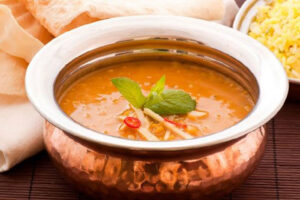
Ingredients
Oil-2 tbsp.
Curry leaves-4-5 no
Chicken stock-3-4 cups
Shredded boiled chicken-1/2 cup
Onion-1 medium, chopped
Carrot-1/2 no chopped
Tomato-2 med sized, chopped
Green chilies-1 tsp chopped
Red chilies-1-2 no slit
Coriander seeds- 2 tsp roasted and powdered
Yellow lentils-1/2 cup mix boiled- optional
Cumin seeds-1 tsp roasted, powdered
Fenugreek seeds-1/2 tsp roasted, powdered
White rice-2 tsp roasted
Black pepper-1/2 tsp crushed
Red chili powder-1/2 tsp
Turmeric powder-1/2 tsp
Salt to taste
Ginger-1 tsp chopped
Garlic-1 tsp chopped
Celery-1 stalk chopped
Coconut milk-1 cup thick
Coriander leaves-2 tbsp. chopped
For garnish
Boiled rice-2 tsp
Lime juice-1-2 tsp add and serve
Method
- in a pan dry roast all the whole spices along with the rice until fragrant and well refreshed, turn off the flame and cool, add in the peppercorns, powder them all together and keep aside.
- In a pan add oil, add in curry leaves, saute the onions, celery, carrots add little salt to taste, add in the ginger, garlic, chilies and continue to saute for a few mins.
- Add in the powdered spices and mix well, add in tomatoes, boiled lentils, coriander leaves, add in the powdered spices and mix well.
- Now add in the chicken stock and chicken pieces and bring to a boil, simmer and cook for 12-15 mins on a medium flame.
- Here we have two options to either cool, puree the above mixture or keep it whole as it is, then add in the coconut milk and simmer for 2-3 mins.
- Turn off the flame and add in lime juice and garnish with boiled rice and serve hot.
SRI LANKAN CHICKEN CURRY
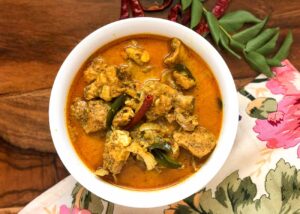
Ingredients
Chicken curry cuts- 500- 750 gms, with bones and skin.
Oil-2 tsp
Ghee-2 tsp
Onion-2 med chopped
Ginger-1 tsp chopped
Garlic-1 tsp chopped
Tomato-2 med sized chopped
Tomato puree-2-3 tsp
Curry leaves- 8-10 no
Green chilies-2 tsp chopped
Sri-lankan curry powder-2 tsp as given above
Red chili powder-1/2 tsp
Turmeric powder-1/2 tsp
Salt to taste
Water as needed
White vinegar-2 tsp
Coconut milk-1 cup or as needed thick variety
Coriander leaves-2 tbsp. chopped
Fried curry leaves/ red chilies for garnish.
Method
- Clean, wash, cut and marinate the chicken pieces with the roasted curry powder, red chili powder, little salt, turmeric powder and vinegar for around 20-25 mins, keep refrigerated.
- Heat oil and ghee in a heavy bottomed pan, add in the onions until they get light pink in color. Add in the ginger, garlic, chilies, curry leaves and fry for a few mins.
- Add in the marinated chicken pieces and saute it well with the onion masala in the pan.
- Add in the chopped tomatoes, puree and saute well, cover and simmer for 5-6 mins, add little water to cook the chicken.
- Continue cooking the chicken curry for 12-15 mins add in the coconut milk and simmer for 4-6 mins, add coriander leaves and serve hot with sri-lankan steamed rice or with roti/ parathas.
EASY COCONUT SAMBAL
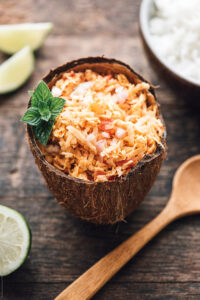
Ingredients
Grated fresh coconut-1 med sized
Shallots- 6-8 no peeled and sliced
Dry red chilies- 8-10 no
Lime juice-2 tsp
Salt to taste
Sugar-1/2 tsp
Method
- Dry grind the red chilies and little salt together to form chili flakes kind of texture.
- Add in the grated coconut to the same grinder jar and continue to churn it once, add sugar and shallots and mix well once more.
- Remove the sambal into a mixing bowl and adjust salt, and add lime juice mix well and keep chilled until being used to go alongside with meals.
SRI LANKAN KUTTU PAROTTA
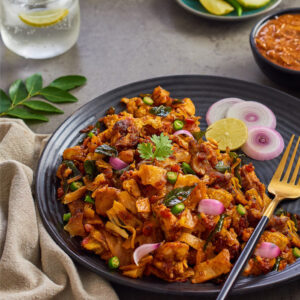
Ingredients
Oil-2-3 tbsp.
Butter/ghee-2 tsp
Leftover rotis/ parottas- 3-4 broken into pieces
Eggs-3 no
Assorted veggies of your choice- carrots/beans/peas/cabbage etc
Onion-2 small chopped
Tomatoes-2 small chopped
Green chilies-2 tsp chopped
Ginger-garlic paste-1 tsp
Water-1/2 cup
Curry leaves- 8-10 no
Salt to taste
Red chili powder-1/2 tsp
Turmeric powder-1/2 tsp
Curry powder-1 tsp as given above
Coriander leaves-2 tbsp. chopped
Lime juice-2 tbsp.
Roasted crushed peanuts-2-3 tsp
Method
- Heat oil/ butter/ghee in a pan add onions and curry leaves and saute for a couple of mins.
- Add in the ginger-garlic paste, green chilies and saute for few seconds, add chili powder, turmeric powder and salt to taste.
- Stir the mixture for a minute, add in the tomatoes and cook until soft and mushy add a little water to fasten the process.
- Break in the eggs/ add in the veggies of your choice and cover the pan with a lid and allow the eggs to cook for a couple of minutes on low flame.
- Add in the cut parottas into the pan and give it all a nice mix to ensure proper mixing, check for salt, add coriander leaves, crushed peanuts, lime juice and serve hot.
SRI LANKAN CRAB CURRY

Ingredients
Oil- 2 tsp
Butter/ghee-2 tsp
Crab- 700 gms- 900 gms
Onion-2 small chopped
Garlic cloves- 2 tsp chopped
Ginger-1 tsp chopped
Curry leaves- 10-12 no
Curry powder-2-3 tsp as given above
Water/stock as needed
Turmeric powder-1/2 tsp
Red chili powder-1/2 tsp
Salt to taste
Coconut milk- 2 cups thick
Tamarind pulp-1/4 cup or as per taste
Lime juice-2 tsp
Coriander leaves-2 tbsp. chopped
Method
- Prepare the crab for using it in the gravy upon cleaning it well and refreshing under water.
- Heat oil and butter/ghee add in onions, curry leaves and saute add in the ginger, garlic, chilies and cook for a minute.
- Add in the curry powder, and continue cooking the mixture, add in little water and cook until onions get a nice brownish tone.
- Add in the tamarind pulp, cleaned crab, lime juice, salt, powdered spices to taste and mix it well.
- Allow to cook for 8-10 mins on a medium flame, add in the coconut milk and continue cooking for 4-5 mins more, add chopped coriander leaves, check for salt and serve hot with steamed rice.
SRI LANKAN TUNA FISH SNACK ROLLS
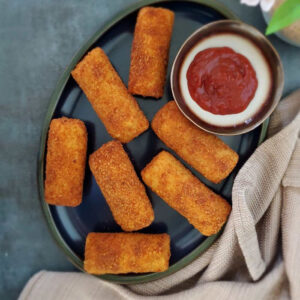
Ingredients
For the pancake batter
Maida-1 and a half cup
Milk-1/2 cup or water
Salt to taste
Oil-2 tsp
For the tuna filling
Oil-1 tsp
Tuna fish-250 gms, tinned/canned, drained
Boiled mashed potatoes-2 small
Carrot-1 small shredded
Leeks-1/4 cup sliced or onion-1 small chopped
Garlic-1 tsp chopped
Green chilies-2 no chopped
Chili flakes-1/2 tsp
Salt and pepper to taste
To fry
Oil as needed
Bread crumbs to coat the rolls
Method
- In a mixing bowl combine together the flour, oil, salt, milk/water and form a nice coating smooth batter.
- Rest for 20 mins, heat up a non-stick pan grease lightly and pour the batter using a round spoon and swirl the batter evenly to form a pancake, on a medium flame allow to cook on both sides for couple of minutes, remove and keep aside.
- Now prepare the filling, heat oil add in the garlic, onions and saute them for a minute, add in the carrots, salt, spices to taste, chili flakes.
- Add in the potatoes and tuna fish and mix well, cook on a low flame cook the mixture for 3-4 mins and remove, cool.
- Now we need to stuff the prepared filling into the earlier prepared pancakes, take around 2-3 tsp of the prepared fish mixture and place it on the pancake, apply maida water paste to seal the edges and shape like spring rolls. Prepare all the rolls.
- Using the leftover pancake batter as made above, dip each roll in the batter or use beaten egg and coat with dry bread crumbs and keep chilled until being used. Heat oil to a medium flame and deep fry the rolls to a nice golden brown color, remove excess oil and cut, serve hot with dips/sauces.
PANI POL COCONUT PANCAKE SWEET
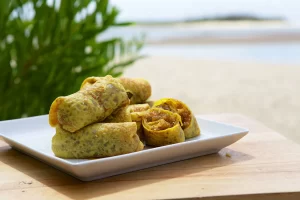
Ingredients
For the pancake mixture
Maida-1 cup
Salt-1 pinch
Oil/ghee-2 tsp
Water/ milk as desired to make the batter
Pinch of baking soda
Egg yolk-1 no
Vanilla essence -1/2 tsp
For the coconut stuffing
Oil/butter/ghee-2 tsp
Fresh grated coconut- 1 cup
Jaggery-1/2 cup
Sugar-2-3 tsp
Cinnamon powder-1 pinch
Green cardamom powder-1 pinch
Chopped nuts-2-3 tsp- almonds/cashews/raisins etc
Method
- Prepare the batter for the pancakes and allow to rest for 12-15 mins.
- Using a non-stick pan, spread out the batter using a round spoon and swirl the pan to spread the batter to form thin pancakes.
- Using a little oil/butter allow them to cook well on both sides and remove once done.
- In a separate pan, heat oil/butter/ghee add in the jaggery and stir well, allow to melt on low flame, add in the grated coconut, powdered cinnamon and cardamom, nuts and mix well.
- Cook this mixture on a low flame for 3-4 mins and remove. While the mixture is still warm we can start filling and rolling up the pancakes and garnish with chopped nuts and arrange them on a serving platter and relish the coconut pancakes.
WATTALAPPAM STEAMED SWEET

Ingredients
Jaggery powder- 200 gms
Eggs- 5 no
Cinnamon powder-1 tsp
Green cardamom-1/2 tsp
Nutmeg powder-1/4 tsp
Pinch of salt
Coconut cream-500ml
Vanilla essence-1 tsp
Cashews/ raisins- 2-3 tbsp. fried
Method
- Dissolve the jaggery powder with ¼ cup water and make a nice thick syrup with it.
- Add the sweet jaggery syrup to the into a bowl with the eggs and using an electric blender and add in the cinnamon, cardamom, nutmeg and pinch of salt.
- Add in the coconut cream, vanilla essence and continue beating for another 2 mins.
- Pour the mixture into a mould, cover with foil and ensure it is nicely packed and sealed up.
- Prepare a steamer, ideally a bamboo one is recommended and steam this pudding for a little over an hour and allow to rest for a few mins, open and check, chill the pudding, cut into squares and garnish with fried nuts, arrange on a platter and serve.
ON A CONCLUDING NOTE
SRI-LANKAN CUISINE is truly a delight to try and adapt into our daily cooking as well to be able to enjoy the robust aromas, variety of flavours to treat our palate! Most of these recipes can also be Indianised in a number of ways for example the curries, gravies, the kuttu parottas concept can be a good example to try and work with when it comes to using leftover rotis etc. one should be open to accepting new ideas, new cuisines, new ways of cooking along with trends which keep coming and going. On a note of recommendation along with my own visit to Sri-Lanka a few years back I truly believe this is one of those good foods to be relished by all of us without doubt.
Happy Cooking!
Celebrity Master Chef Dr Kaviraj Khialani is a Mumbai-based hotel-restaurant and food consultant. He is specialised in over 33 international cuisines and has quality experience with hotels and airlines as a part of his long journey of over two decades in his chosen field. Chef Kaviraj is a renowned author, academician, food designer, writer and has also been awarded several national awards and global recognitions for his talent & outstanding achievements. Besides having been featured on several food shows on ColorsTV and Star Plus he is a mentor, coach and guide to aspiring to be future chefs and hoteliers of tomorrow.
He can be contacted at twitter: @kaviraj_chef, Mobile: 91 9820939336. Mail: chefkaviraj249@gmail.com
